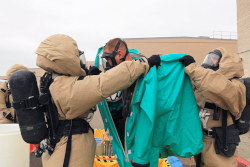Decontamination Methods
All personnel, clothing, equipment, and samples leaving the contaminated area of a site (generally referred to as the Exclusion Zone) must be decontaminated to remove any harmful chemicals or infectious organisms that may have adhered to them.
Decontamination strategies either:
- physically remove contaminants,
- inactivate contaminants by chemical detoxification or disinfection/sterilization, or
- remove contaminants by a combination of both physical and chemical means.
Physical Removal
Gross contamination can be removed by physical means involving dislodging/displacement, rinsing, wiping off, and evaporation. Physical methods involving high pressure and/or heat should be used only as necessary and with caution since they can spread contamination and cause burns. Contaminants that can be removed by physical means can be categorized as follows:
- Loose contaminants: Dusts and vapors that cling to equipment and workers or become trapped in small openings, such as the weave of the clothing fabrics, can be removed with water or a liquid rinse. Removal of electrostatically attached materials can be enhanced by coating the clothing or equipment with anti-static solutions. These are available commercially as wash additives or anti-static sprays.
- Adhering contaminants: Some contaminants adhere by forces other than electrostatic attraction. Adhesive qualities vary greatly with the specific contaminants and the temperature. For example, contaminants such as glues, cements, resins, and muds have much greater adhesive properties than elemental mercury and, consequently, are difficult to remove by physical means. Physical removal methods for gross contaminants include scraping, brushing, and wiping. Removal of adhesive contaminants can be enhanced through certain methods such as solidifying, freezing (e.g., using dry ice or ice water), adsorption or absorption (e.g., with powdered lime or kitty litter), or melting.
- Volatile liquids: Volatile liquid contaminants can be removed from protective clothing or equipment by evaporation followed by a water rinse. Evaporation of volatile liquids can be enhanced by using steam jets. With any evaporation or vaporization process, care must be taken to prevent worker inhalation of the vaporized chemicals.
Knowledge Check Choose the best answer for the question.
3-5. Why should using physical methods involving high pressure and/or heat be used only as necessary and with caution to remove gross contaminants?
You forgot to answer the question!

